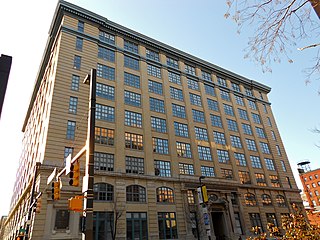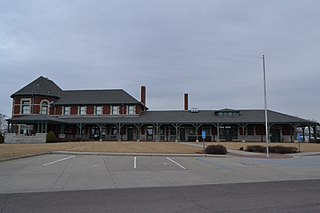
The Missouri State Fair is the state fair for the state of Missouri, which has operated since 1901 in Sedalia, Missouri. It includes daily concerts, exhibits and competitions of animals, homemade crafts, shows, and many food/lemonade stands, and it only lasts 11 days. Its most famous event is the mule show, which has run since its inception. The fairgrounds are located at 2503 W 16th Street on the southwest side of the city at the intersection of West 16th Street and South Limit Avenue.

The Coca-Cola Bottling Company Building, also known as the Kelly Press Building, is a historic commercial building located on Hitt Street in downtown Columbia, Missouri. It was built in 1935, and is a 1 1/2-story, Colonial Revival style brick building with a side gable roof with three dormers. It has a long one-story rear ell. Today it houses Uprise Bakery, Ragtag Cinema, Ninth Street Video, and Hitt Records.

Sonneborn Building, also known as Paca-Pratt Building, is a historic loft building in Baltimore, Maryland, United States. Designed by Theodore Wells Pietsch, it is a nine-story loft building constructed in 1905 of "fireproof" reinforced-concrete construction, faced in buff-colored brick, with a coursed ashlar foundation and stone trim. Its detailing reflects the Neoclassical Revival of the early 20th century. It was built for Henry Sonneborn and Company as a vertical clothing manufactory and was the tallest and largest strictly manufacturing building in the city of Baltimore.

The Knickerbocker Apartments are located at 501-535 Knickerbocker Place in the Valentine Neighborhood of Kansas City, Missouri. The Late 19th and 20th Century Revival style building was designed by Leon Grant Middaugh and J.A. Rose, and was built in 1909. It is significant for its architecture, and was added to the National Register of Historic Places in 2003.

The Missouri State Teachers Association Building is a historic building located at Columbia, Missouri. It was built in 1927 and houses the Missouri State Teachers Association Headquarters. The building is located on South 6th Street on the University of Missouri campus and is a two-story, Tudor Revival style brick building. It was the first building in the United States built specifically to house a state teachers association. A historical marker on the site commemorates the lands former tenant "Columbia College," the forerunner of the University of Missouri.

The Pierce Pennant Motor Hotel, also known as the Candle Light Lodge, is a historic hotel complex that is located on what once was U.S. Route 40, which is now known as Business Loop 70 West in Columbia, Missouri. The hotel complex was constructed in 1929 and is in the Colonial Revival style. The hotel was also a gas station and garage, and was owned by Pierce Petroleum Company, a subsidiary of Standard Oil. Initially the hotel and garage complex was to be one of several along U.S. Hwy 40, each to be spaced about 150 miles apart from New York to San Francisco.

The State Bank and Trust Company Building, more commonly known as the Belvada, is a historic bank building located at 102 Brougher Avenue in Tonopah, Nevada. The building was constructed in 1906 for the State Bank and Trust Company, a local bank founded in 1902. Architect George E. Holesworth designed the building in the Classical Revival style. Holesworth's design features granite pilasters separating the building's bays, a dentillated metil cornice with modillions along the roof, and an egg-and-dart cornice at the top of the first floor. The bank moved into the building in June 1907, but it only occupied it for four months. The bank had lent the L.M. Sullivan Trust Company, a land speculating company, a large sum, and when the company failed, the bank did as well. In 1908, the Nevada Club Saloon opened in the building; it was joined by the First National Bank of Nevada later in the year. The five-story building and the nearby Mizpah Hotel, also five stories, were the tallest buildings in the state until 1927.

St. Joseph's Commerce and Banking Historic District is a national historic district located at St. Joseph, Missouri. The district encompasses 39 contributing buildings in the central business district of St. Joseph. It developed between about 1859 and 1950, and includes representative examples of Italianate, Classical Revival, and Streamline Moderne style architecture. Located in the district are the separately listed German-American Bank Building, Corby-Forsee Building, Missouri Theater and Missouri Theater Building, and Missouri Valley Trust Company Historic District. Other notable buildings include the Ballinger Building (1889), Commerce Building, First National Bank of St. Joseph, Lehman's, Plymouth Building (1908), and the United Building (1917-1918) by the architecture firm of Eckel & Aldrich.

Missouri Valley Trust Company Historic District, formerly known as the Market Square Historic District, is a national historic district located at St. Joseph, Missouri. The district encompasses six contributing buildings in the central business district of St. Joseph. It developed between about 1859 and the 1860s, and includes representative examples of Renaissance Revival style architecture. The primary building is the Bank of the State of Missouri (1859).
Market Square Historic District was a national historic district located at St. Joseph, Missouri. The district encompassed 19 contributing buildings in the central business district of St. Joseph. It developed between about 1850 and 1940, and included representative examples of Renaissance Revival style architecture. The primary building is the Bank of the State of Missouri (1859). Most of the remaining buildings were demolished in 1973.

Broadway District is a national historic district located at Hannibal, Marion County, Missouri. The district encompasses 28 contributing buildings in the central business district of Hannibal. It developed between about 1866 and 1934, and includes representative examples of Italianate, Classical Revival, and Art Deco architecture. Notable buildings include the Lakenan Building, Kresge Building (1931), Second Farmers and Merchants Bank, Sproul-Cash Store (1901), Hannibal Trust Company (1909-1910), Hickman Block, and Robinson Brothers.

Hotel Bothwell is a historic hotel building located at Sedalia, Pettis County, Missouri. It was designed by H.L. Stevens & Company and built in 1927. It is a seven-story, Classical Revival style reinforced concrete building faced with tan brick and stone trim. The basement, first, and second floors occupy the full rectangular parcel, whereas the upper stories have an L-shaped plan.

Building at 217 West Main Street, also known as the Open Door Service Center Building, is a historic commercial building located at Sedalia, Pettis County, Missouri. It was built in 1874, and is a two-story, "L"-shaped, Italianate style brick building. A wing was added in 1906. It features a decorative metal cornice and three round arched windows. The building is known to have housed a brothel in the late-19th and early-20th centuries.

William H. Gentry House, also known as Oak Dale, Cloney Family Farm, and Curry Farm, is a historic home located near Sedalia, Pettis County, Missouri. It was built about 1855, and is a two-story, vernacular Greek Revival style brick I-house. It has a central passage plan, two-story rear ell, and features a pedimented, two-story front portico.

C.C. Hubbard High School, also known as Lincoln School and Lincoln-Hubbard School , is a historic high school located at Sedalia, Pettis County, Missouri. It was built in 1928, and is a two-story, symmetrical brick building. Projecting wings were added in 1952 to house a cafeteria and an industrial arts classroom. It is the last remaining building in Sedalia, Missouri, to be built and used as a separate school for African-American students. The composer and music educator L. Viola Kinney taught music and English at the school for 35 years. The school closed in 1962. The former school has been renovated as an apartment building.

Sedalia station, also known as the Katy Depot, is a historic train station located at Sedalia, Pettis County, Missouri. It was built in 1895 by the Missouri, Kansas and Texas Railroad. It is a 2 1/2-story, Romanesque Revival style red brick building on a limestone foundation. It has a two-story, modified octagonal primary facade, slate-covered hip roofs, and a broad encircling gallery. The station closed to passenger traffic in May 1958. The building houses the Sedalia welcome center.

Sedalia Public Library is a historic Carnegie library building located at Sedalia, Pettis County, Missouri. It was designed by the architecture firm Shepley, Rutan and Coolidge and built in 1900. It is a two-story, cruciform plan, Greek Revival style wood and steel frame building with brick walls and limestone and terra cotta facing. It is seven bays wide with an open tetrastyle Ionic order portico on the front facade. It was the first public library in the state of Missouri to receive a Carnegie grant for construction of a library building. The grant was $50,000.

The Evans Manufacturing Company Building, also known as Metropolitan Supply Company Building, is a historic building located in Cedar Rapids, Iowa, United States. The Brown-Evans Manufacturing Company, which made men's work clothing, was relocated from Sedalia, Missouri to Cedar Rapids when this building was completed in 1919. It was built in the 4th Street Railroad Corridor, which had attracted various industrial enterprises in the years before and after World War I. The Modern Movement building was designed according to the principles of industrial design of the time in light of the Triangle Shirtwaist Factory fire in 1911. Its fireproof masonry construction was intended to lessen the risk of fires. Storage of raw stock was located in the basement, cutting and storage of finished stock was located on the first floor, and sewing was done on the second floor and balcony. Its open floor plan allowed for assembly line production.


























